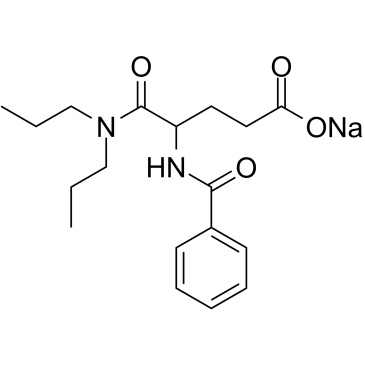99247-33-3
| Name | sodium,4-benzamido-5-(dipropylamino)-5-oxopentanoate |
|---|---|
| Synonyms |
N-Benzoyl-N',N'-dipropyl-DL-isoglutamine Sodium-Potassium salt
Glutaramic acid,4-benzamido-N,N-dipropyl-,sodium salt,dl dl-4-Benzamido-N,N-dipropylglutaramic acid sodium salt Proglumide sodium salt Pentanoic acid,4-(Benzoylamino)-5-(dipropylamino)-5-oxo-,monosodium salt,(+-) 4-Benzoylamino-5-dipropylamino-5-oxopentanoic acid Sodium-Potassium salt Proglumide sodium |
| Description | Proglumide sodium is a nonpeptide and orally active cholecystokinin (CCK)-A/B receptors antagonist. Proglumide sodium selective blocks CCK’s effects in the central nervous system (CNS). Proglumide sodium has ability to inhibit gastric secretion and to protect the gastroduodenal mucosa. Proglumide sodium also has antiepileptic and antioxidant activities[1][2][3][4][5]. |
|---|---|
| Related Catalog | |
| Target |
Cholecystokinin (CCK)-A/B receptors[1][2] |
| In Vitro | In an in vitro study, Proglumide at concentrations between 0.3-10 mM inhibits CCK-stimulated amylase release dose-dependently, while Proglumide does not influence the basal amylase release at concentrations between 0-3 mM. Dose-response curves to CCK for amylase release shifted to the right with increase in Proglumide concentration. This inhibition by Proglumide is reversible. In addition, the effect of Proglumide is selective for CCK and its related peptide[2]. The incubation of HT29 cells with Proglumide significantly reduces the [3H]-thymidine incorporation to HT29 cells in a dose-dependent manner, with an IC50 of 6.5 mM. Proglumide reduces in a dose-dependent manner the percentage of necrosis with a parallel increase of apoptosis up to 70%[3]. |
| In Vivo | Proglumide (250-750 mg/kg; intraperitoneal injection; adult male Sprague Dawley rats) treatment is significantly effective in ameliorating the seizure activities, cognitive dysfunctions, and cerebral oxidative stress[1]. Animal Model: Adult male Sprague Dawley rats (200-250 g; 2 months old) are induced status epilepticus (SE)[1] Dosage: 250 mg/kg, 500 mg/kg, and 750 mg/kg Administration: Intraperitoneal injection Result: Dose-dependently and significantly increased the latencies to seizure and SE. Significantly and dose-dependently attenuated Li-PC (SE) induced increase in thiobarbituric acid (TBARS) and catalase (CAT), attenuated Li-Pc induced decrease in SOD, and attenuated depletion of GSH and glutathione-S transferase (GST) in the hippocampus and striatum. |
| References |
| Molecular Formula | C18H25N2NaO4 |
|---|---|
| Molecular Weight | 356.39200 |
| Exact Mass | 356.17100 |
| PSA | 93.03000 |
| LogP | 1.53850 |
CHEMICAL IDENTIFICATION
HEALTH HAZARD DATAACUTE TOXICITY DATA
|
| Personal Protective Equipment | Eyeshields;Gloves;type N95 (US);type P1 (EN143) respirator filter |
|---|---|
| RIDADR | NONH for all modes of transport |
| WGK Germany | 3 |
| HS Code | 2924299090 |
| HS Code | 2924299090 |
|---|---|
| Summary | 2924299090. other cyclic amides (including cyclic carbamates) and their derivatives; salts thereof. VAT:17.0%. Tax rebate rate:13.0%. . MFN tariff:6.5%. General tariff:30.0% |
